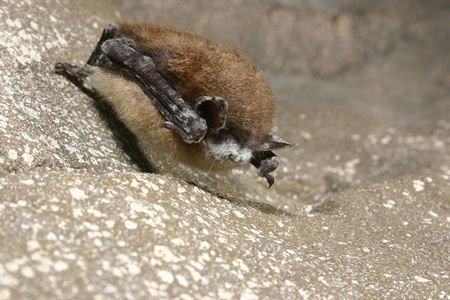
Press release from the Indiana DNR:
Bat tests positive for white-nosed fungus
The Indiana Department of Natural Resources and the U.S. Fish and Wildlife Service have received confirmation that a bat found in a southern Indiana cave has tested positive for the fungus that causes white-nose syndrome. The case is the state’s first for the WNS fungus, believed to be responsible for the deaths of more than one million bats in the eastern United States.
Researchers doing biennial bat counts at Endless Cave in Washington County discovered two little brown bats on Jan. 23 that exhibited the white fungus characteristic of WNS. One of the bats was euthanized and sent to the U.S. Geological Survey’s National Wildlife Health Center in Madison, Wisconsin, which later confirmed the presence of the WNS-associated fungus.
Additional bats with signs of WNS were discovered during routine bat count surveys at other caves.
“We knew WNS was likely to reach Indiana caves this year, and we have been working closely with biologists from the DNR to prepare for this as well as we could,” said Tom Melius, the Service’s Midwest Regional Director. “Nonetheless, it is devastating to actually confirm the presence of the fungus and witness the symptoms of WNS in bats. While there is currently no cure and no treatment for this disease, we will put all our energies into contributing to the ongoing efforts to understand and combat WNS.”
The fungus has been discovered in Connecticut, Delaware, Maryland, Massachusetts, Missouri, New Hampshire, New Jersey, New York, Oklahoma, Pennsylvania, Tennessee, Vermont, Virginia, West Virginia and the provinces of Ontario and Quebec, Canada.
Researchers associate WNS with a newly identified fungus, Geomyces destructans, which thrives in the cold and humid conditions characteristic of caves and mines used by hibernating bats.
Experts believe WNS is transmitted primarily from bat to bat, but they also caution it may be transmitted by humans inadvertently carrying fungal spores from cave to cave on their clothing and caving gear.
The DNR closed public access to all caves on state-managed properties two years ago, including Endless Cave in the Cave River Valley Natural Area managed by the DNR Division of State Parks & Reservoirs as part of Spring Mill State Park.
“We will continue to keep all of our caves closed, and we are urging private cave owners to either not allow access to their caves or require visitors to follow USFWS decontamination procedures,” DNR deputy director John Davis said. “The whole effort is to slow the spread and have movement of the disease not be exacerbated by human interference.”
Physical signs associated with WNS are a white fungus on the bat’s nose, wings, ears or tail membrane. Bats afflicted with WNS often exhibit unusual behavior in winter, including clustering near hibernacula entrances. Affected bats also may leave their hibernacula during the day and may be observed flying or clinging to rocks outside or on nearby buildings. Dead or dying bats are often found on the ground near affected areas.
For more information about white-nose syndrome, visit www.dnr.in.gov/batdisease and https://www.whitenosesyndrome.org/















